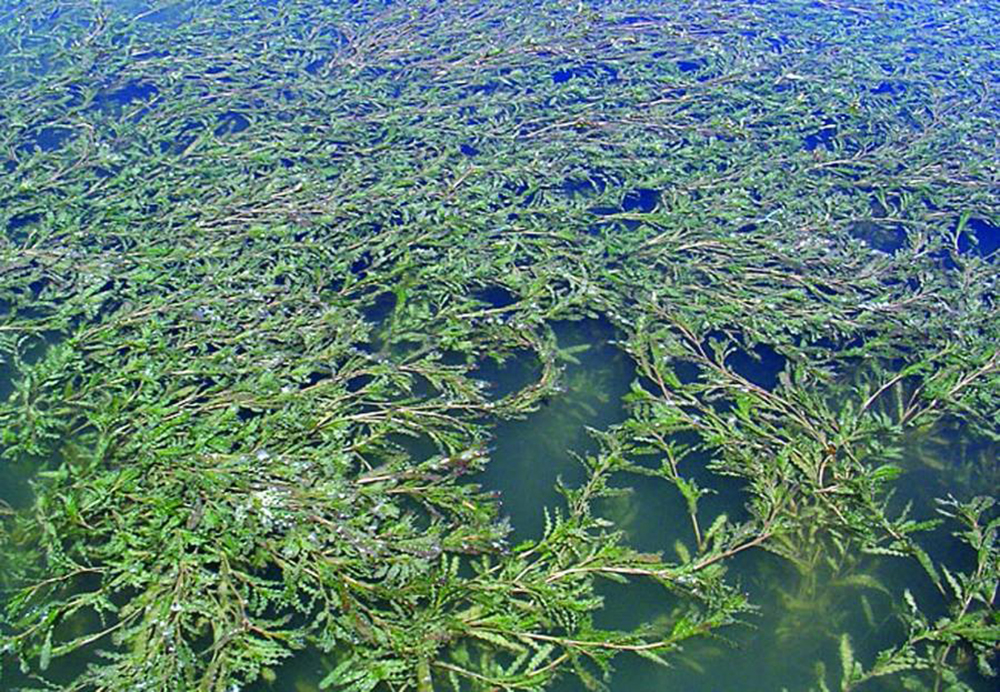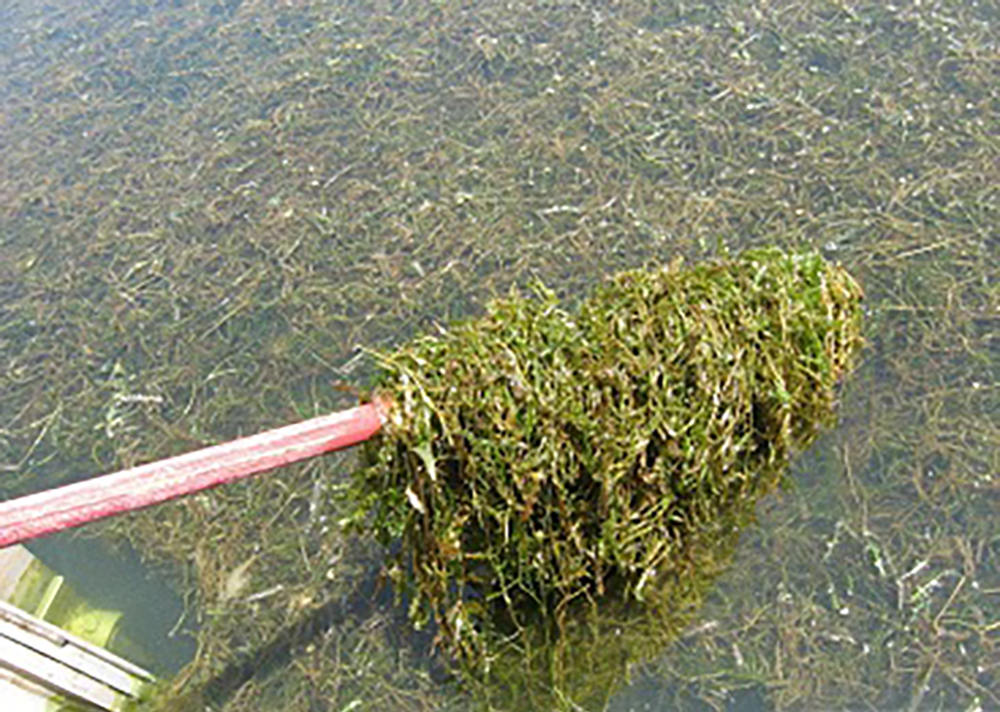Shared by the Bukreys.This may seem to be an insignificant concern considering the global pandemic, but eventually things in the North Woods will return to normal. In the meantime, we have another serious situation regarding a very aggressive invasive species that is threatening the entire Turtle River Watershed – including the Turtle Flambeau Flowage.
The Bottom Line; The invasive species is called Curly Leaf Pondweed (CLP). It’s already established in Rice Lake, and has moved down the Turtle River, recently reaching the edge of Pike Lake. If we don’t aggressively fight this, it will migrate to Lake of the Falls, and the Flowage – and probably fairly soon. CLP drops floating seeds in mid-summer and the current of the Turtle River will certainly move those seeds along. Poisoning, or cutting the plant isn’t feasible because of the shallow waters and the current, hand pulling is our best approach. So we need volunteers, and we need many of you….
Background; Several years ago, Curly Leaf Pondweed (CLP) was discovered in Rice Lake which is part of the Turtle River watershed. Efforts to control it via mowing have failed and the plant has continued to migrate downstream. It is now in the Turtle River below Rice Lake and there are pioneer plants in Pike Lake. Following Pike Lake is another section of the Turtle River, then Lake of the Falls, and then the Flowage itself.
CLP is currently a tragedy on Rice Lake, as it would likely be on any of our lakes in the Turtle River Watershed (including all of the Flowage) because most of our lakes are ideal environments for this plant – relatively shallow, many bays, etc. This plant overruns native plant species and spreads itself over the surface, eliminating fishing, and navigation in worst cases. Not only would that be a horrible blow to, arguably, the most unspoiled watershed left in WI, it will also be a serious blow to the economy of Mercer and Iron County. Property values, in particular in the shallower bays would likely take a serious hit as well.
One of the goals of ICLRA and the new Turtle River Watershed Stewardship Project is to fight this infestation. A three-year plan has been developed in cooperation with the Rice Lake Association, which has borne the brunt of this problem for the past seven years, with the incredible assistance of the people at the Wisconsin Department of Natural Resources and with the Iron County Land and Water Conservation Department
There are two components to this plan. Each year we will:
- PRIORITY 1; STOP THE FURTHER SPREAD via finding and destroying the pioneer plants in the Turtle River between Rice and Pike lakes and in Pike Lake itself. A grant application (attached) has been filed with the DNR as of this date to fund this effort. The Rice Lake association is the sponsor of this Aquatic Invasive Species Rapid Response (AISRR in DNR terms) grant. In May, professional limnologists will survey Pike Lake and the river to find the plants. Going along will be volunteers in canoes or kayaks who will pull the weeds as they are identified. A process for on-going surveillance of the section of the river will be established to continually keep it in check. The funding for equipment and expertise for this project will be funded 75% by the DNR and 25% by the Rice Lake Association. The DNR credits the Rice Lake Association for our volunteer hours greatly helping cover their 25%.
- PRIORITY 2; ATTACK THE SOURCE via a hand-pulling effort on Rice Lake. This is a low-tech, high man-hour project. The DNR is funding the entire cost of the limnologists who will do the required identification and reporting activities. The rest, as of this moment, is up to us. We need as many people in boats and along shore lines as possible. Pulling, collecting and disposing of the weeds is a huge effort…..but if we don’t do it this year, next year will be that much harder, and at some point it simply becomes unfeasible. We cannot ignore this. Also, please note that this will not be done in one year – this will need to be an on-going effort. The project training is currently scheduled for May and the pulling activities for May and June obviously dependent on the Coronavirus issues.
WHY THE LOW TECH PULLING PROCESS?; Chemicals won’t work because the current in the lake/river which moves the poison off of the target plant. Plus, chemicals can hurt native plant species, fish and even humans. Mowing is too expensive and just spreads the plants down-stream.
So, please consider volunteering….and please reach out to your friends and neighbors to volunteer. If you’re not physically able to pull weeds, or you don’t have a canoe or kayak, there are other ways to participate. Training regarding plant identification will be offered this spring via the DNR.
Iron County Lakes and Rivers Alliance, Inc.
Zach Wilson from the Iron County Department of Land and Water Conservation, and he is planning to meet with LOFA members to discuss this problem at 1:00pm on Tuesday, May 26 (the day after Memorial Day) at Beaver's Resort. Also, Emily Heald, the Water Program Coordinator at the North Lakeland Discovery Center, is scheduled to give a presentation on Aquatic Invasive Species identification at our annual picnic on Sunday, August 2. Details on both of these meetings will be on the
LOFA website and in the annual newsletter, which you'll get in the mail around May 1.
https://dnr.wi.gov/topic/Invasives/fact/CurlyLeafPondweed.html






